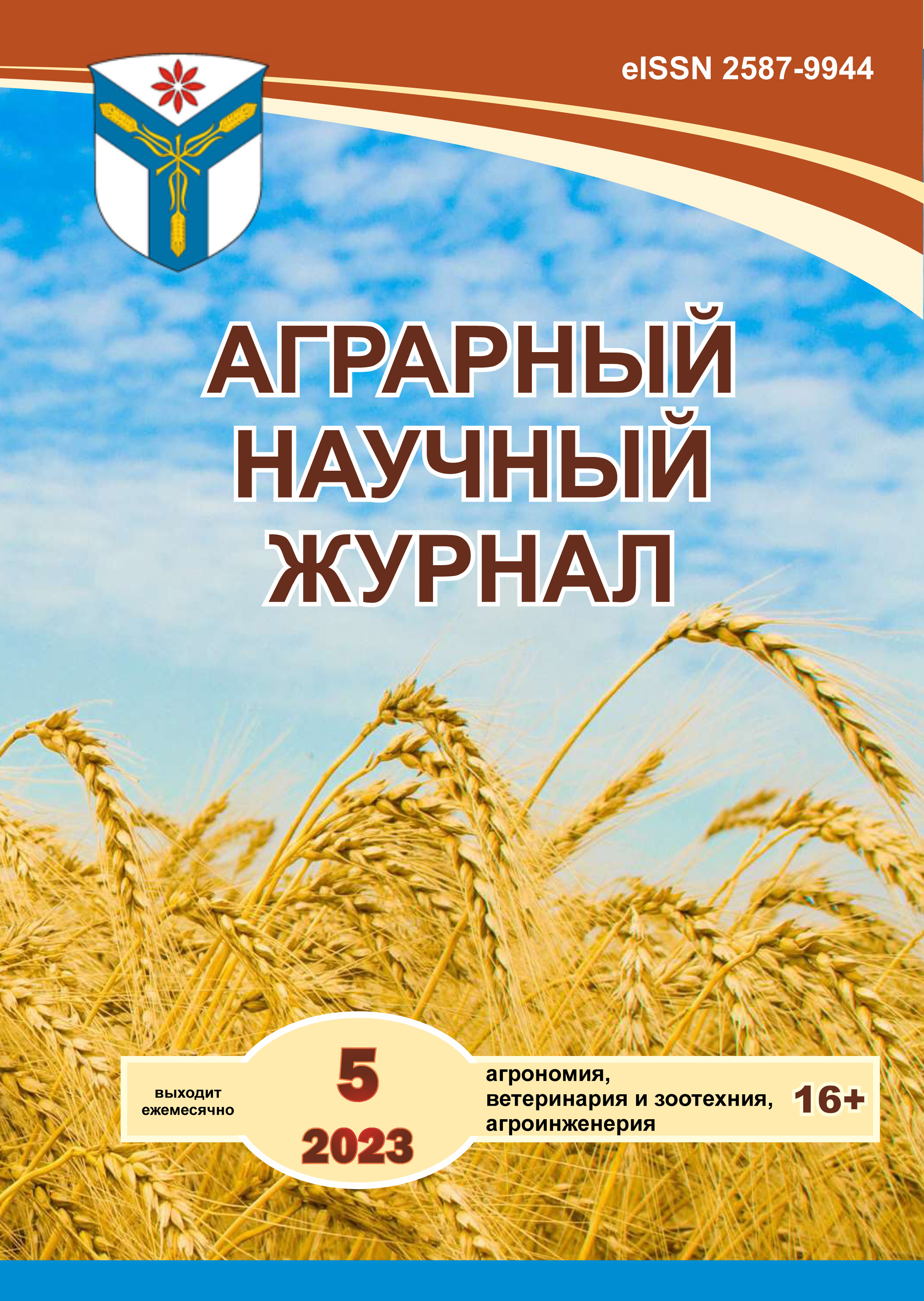Phytopathological assessment of Azerbaijan origin bread wheat (Triticum aestivum L.) genotypes against yellow rust
DOI:
https://doi.org/10.28983/asj.y2023i5pp16-23Keywords:
Triticum aestivum L., Puccinia striiformis f. sp. tritici, yellow rust, susceptible, SPADAbstract
Yellow rust (Puccinia striiformis f. sp. tritici) on bread wheat (Triticum aestivum L.) has resulted in significant reductions in the yield losses and wheat grain quality. Infection rate to yellow rust disease and evaluation of the SPAD value of 90 soft wheat genotypes we studied has been implemented in the conditions of the Absheron Peninsula, the territory of the Absheron Experimental Base of ANAS ( N. 40°24.001? , E. 49°49.001? , H. = 50 m. ) in 2017-2020 years. Infection rate to yellow rust disease was 0-100 S. An indicator of the SPAD value we studied has changed from 28.9 to 83.5 between genotypes. The average indicator of this symptom was 50.5. The sample with the highest SPAD value of the soft wheat genotypes we studied was genotype k9530 belonging to the Erythrospermum variety, which had an indicator of 83.5. Infection rate to the yellow rust of this sample was 0 and showed an immune reaction. Different variety, as can be seen from the appreciation of resistance rate for the yellow rust and the value of the SPAD had different infection rates and SPAD values. As a result of this evaluation, although there was partial conformity, full sameness was not observed. Some genotypes had high SPAD values as resistance to the yellow rust. The cluster analysis is based on the Euclidean distance index of the WARD method of the PAST statistical software package. The genotypes we studied have grouped into 6 main clusters according to indicated tokens. According to the euclidean distance index, the farthest genotypes of the cluster were genotype k9530 from the Erythrospermum variety and genotype k7252 from the Milturum variety (54.63). It can be explained by the fact that they belong to different variety.
Downloads
References
Гаджиева С. В. Изучение генетического разнообразия генотипов дикого граната (Punica granatum L.) Азербайджана с использованием маркеров ISSR // Вестник КрасГАУ. 2020. № 3. C. 20–28.
Quality indicators of various durum wheat (T. Durum Desf.) Samples and determination of their tolerance to abiotic stresses (salinity and drought) / R. T. Aliyev et al. // European Journal of Natural History. 2020. No. 4. P. 3–8.
Chen X. M. Epidemiology and control of stripe rust (Puccinia striiformis f. sp. tritici) on wheat // Can J PlantPathol. 2005. No. 27. P. 314–337.
Devadas R., Lamb D. W., Simpfendorfer S., Backhouse D. Evaluating ten spectral vegetation indices for identifying rust infection in individual wheat leaves // PrecisionAgric. 2009. No. 10. P. 459–470.
Eversmeyer M., Kramer C. Survival of Puccinia recondita and P. gramini suredinio spores as affected by exposure to weather conditions at one meter // Phytopathology. 1994. No. 84(4). P. 332–334.
Gooding M. J., Dimmock J.P.R.E., France J., Jones S. A. Green leaf area decline of wheat ?ag leaves: the in?uence of fungicides and relationships with mean grain weight and grain yield // Ann. Appl. Biol. 2000. 136. P. 77–84.
Hammer O., Harper D. A., Ryan P. D. PAST: paleontological statistics software package for education and data analysis. Palaeontol. Electron. 2001. Vol. 4. P. 1–9.
Hovmoller M. S., Walter S., Justesen A. F. // Escalating threat of wheat rusts. Science. 2010. No. 29(5990). P. 369–369.
Kuckenberg J., Tartachnyk I., Noga G., Detection and differentiation of nitrogen-de?ciency, powdery mildew and leaf rust at wheat leaf and canopy level by laser-induced chlorophyll ?uorescence // Biosyst. Eng. 2009. No. 103. P. 121–128.
Line R. F. Stripe rust of wheat and barley in North America: A retrospective historical review // Annu Rev Phytopathol. 2002. No. 40. P. 75–118.
Genotyping by Sequencing and Rust Resistance of Azerbaijani Durum Wheat Germplasm / M. Abbasov et al. // Journal of Plant Physiology & Pathology. J. PlantPhysiolPathol. 2021. Vol. 9. Is. 2. P. 1–9.
Morgounov A., Yessimbekova M., Rsaliev S., Baboev S., Mumindjanov H. High-yielding winter wheat varieties resistant to yellow and leaf rust in Central and Asia. In: Proceeding of the 11th International cereal rusts and powdery mildew conference. 22-27 August, John Innes Centre, Norwich, UK. European and Mediterranean Cereal Rust Foundation, Wageningen, Netherlands, Cereal rusts, and powdery mildews Bull. 2004. P. 52.
Peterson R. F., Campbell A. B., Hannah A. E. A diagrammatic scale for estimating rust intensity on leaves and stems of cereal // Can. J. Res. 1948. No. 26. P. 496–500.
Robert C., Bancal M. O., Ney B., Lannou C. Wheat leaf photosynthesis loss due to leaf rust, with respect to lesion development and leaf nitrogen status // New Phytol. 2005. No.165. P. 227–241.
Roelfs A. P., Singh R. P., Saari E. E. Rust Diseases of Wheat: Concepts and methods of disease management. Mexico, 1992. 81 p.
Leaf tip necrosis, molecular markers and Lr46/Yr29 / G. M. Rosewarne et al. // Theor. Appl. Genet. 2006. No. 112. P. 500–508.
Singh R. P., Nelson J. C., Sorrells M. E. Mapping Yr28 and other genes for resistance to stripe rust in wheat // CropSci. 2000. No. 40. P. 1148–1155.
Disease impact on wheat yield potential and prospects of genetic control / R. P. Singh et al. // Annu Rev Phytopathol. 2016. 54(1). P. 303–322.
Teena M., Manickavasagan A. Thermal Infrared Imaging. In: Manickavasagan A., Jayasuriya H. (Eds.), Imaging with Electromagnetic Spectrum. Springer, Heidelberg, Berlin, Germany, 2014. P. 147–173.
Effectiveness of wheat yellow rust resistance genes in different parts of Iran / M. Torabi et al. // Cereal Rusts Powdery Mildews Bull. 1995. No. 23. P. 9–12.
High-temperature adult plant (HTAP) stipe rust resistance gene Yr36 from Triticum turgidum sp. dicocoides is closely linked to the grain protein content locus Gpc-BI / C. Uauy et al. // Theoritical and Applied Genetics. 2005. No. 112. P. 97–105.
Downloads
Published
Issue
Section
License
Copyright (c) 2023 The Agrarian Scientific Journal

This work is licensed under a Creative Commons Attribution-NonCommercial-NoDerivatives 4.0 International License.








